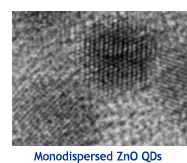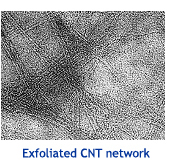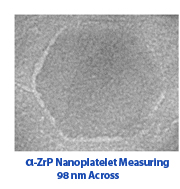Texas A&M University

Nanomaterials
A nanometer (nm) is one billionth (10-9) of a meter. When the dimension of a material drops within this nm length scale, the nature of the interactions between molecules and atoms within this material becomes different from that of the bulk. Such materials are not only fundamentally unique but also useful as “nano-scaled building-blocks” for a variety of applications.
The dispersion of nanomaterials is crucial for understanding the fundamentals because aggregation significantly suppresses their superior properties. Also, dispersed nanomaterials have enormous surface and interfacial areas, which are essential for their intended applications, such as gas storage, energy conversion efficiency, transportation property, thermal stability, mechanical and optical properties. In our group, we study three classes of nanomaterials: 0-dimensional ZnO quantum dots, 1-dimensional carbon nanotubes, and 2-dimensional α-zirconium phosphate nanoplatelets.
ZnO quantum dots (QDs): ZnO is an important semiconductor material. Its large bandgap of 3.3 eV and high exciton binding energy of 60 meV at room temperature makes it ideal for short-wavelength optoelectronic applications. We have developed a simple colloidal method to prepare monodisperse ZnO QDs with high purity. We have developed techniques to individually disperse ZnO QDs in various polymer matrices. One technique uses α-ZrP nanoplatelets (see below) to disperse ZnO QDs without using organic surfactants. Another technique utilizes ZnO QDs grafted with polymers to make melt-blendable polymers. More recently, we have successfully achieved the self-assembly of ZnO QDs into colloidal crystals. Significant efforts have also been made in understanding the antimicrobial effect and cytotoxicity of ZnO QDs.
applications. We have developed a simple colloidal method to prepare monodisperse ZnO QDs with high purity. We have developed techniques to individually disperse ZnO QDs in various polymer matrices. One technique uses α-ZrP nanoplatelets (see below) to disperse ZnO QDs without using organic surfactants. Another technique utilizes ZnO QDs grafted with polymers to make melt-blendable polymers. More recently, we have successfully achieved the self-assembly of ZnO QDs into colloidal crystals. Significant efforts have also been made in understanding the antimicrobial effect and cytotoxicity of ZnO QDs.
Carbon nanotubes (CNTs): De-bundling of CNTs into individual tubes is of tremendous importance. Recently, our group has developed a simple colloidal method to achieve  individually dispersed CNTs in various solvents and polymers in large quantities. Exfoliated CNT network has been built. Significant effort is now underway to take the best advantage of exfoliated CNTs for various applications including mechanical reinforcement, electrical conductivity, nano- and micro- electronics and devices, and aerospace applications.
individually dispersed CNTs in various solvents and polymers in large quantities. Exfoliated CNT network has been built. Significant effort is now underway to take the best advantage of exfoliated CNTs for various applications including mechanical reinforcement, electrical conductivity, nano- and micro- electronics and devices, and aerospace applications.
α- Zirconium phosphate nanoplatelets (α-ZrP): α-ZrP nanoplatelets are synthetic analogs to the naturally occurring layered silicates, some examples which are montmorillonite and bentonite. α-ZrP are hexagonal crystalline nanoplatelets possessing very similar physical and chemical properties to layered silicates, which has been widely used in enhancing the mechanical, thermal and barrier properties of polymers. An advantage of using α-ZrP is that it can be synthesized easily with various sizes ranging from 100 nanometers to 1 micron with a well-controlled size distribution. We have recently discovered that α-ZrP is particularly effective at debundling tightly bound CNT bundles, a novel alternative to using excessive surfactants or strong oxidation to separate CNT bundles.
crystalline nanoplatelets possessing very similar physical and chemical properties to layered silicates, which has been widely used in enhancing the mechanical, thermal and barrier properties of polymers. An advantage of using α-ZrP is that it can be synthesized easily with various sizes ranging from 100 nanometers to 1 micron with a well-controlled size distribution. We have recently discovered that α-ZrP is particularly effective at debundling tightly bound CNT bundles, a novel alternative to using excessive surfactants or strong oxidation to separate CNT bundles.
To learn more about debundling carbon nanotubes using α-ZrP please click here
Advanced Polymer Nanocomposites
Polymer nanocomposites are an important class of advanced materials with unique properties that are having a growing impact on our daily lives. The inclusion of inorganic fillers in a polymer improves its mechanical strength, anti-flammability, dimensional stability and other properties. With the selection of appropriate fillers, existing properties of the polymer can be enhanced or new properties can be acquired that is not usually associated with the polymer. The dispersion of nanosized fillers (nanofillers) in the polymer is often the most challenging and crucial problem. Most of the properties that we seek to improve are achievable only if a homogeneous dispersion of the nanofiller is maintained. Nanofillers tend to aggregate due to strong van der Waals attraction, which makes it necessary to develop strategies to overcome this attraction. We have developed several techniques to achieve this:
Epoxy/α-ZrP Nanocomposite
Epoxy/CNT/α-ZrP Nanocomposites
PMMA/ZnO nanocomposites
Other Related Fields: